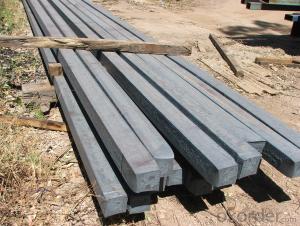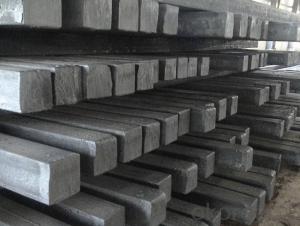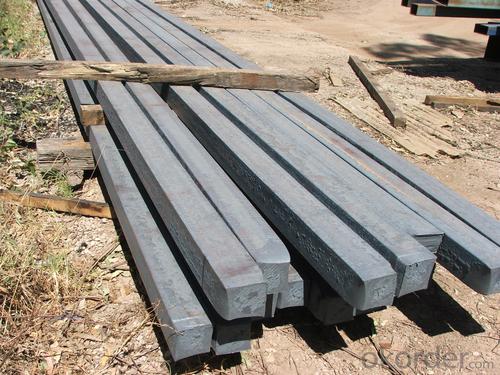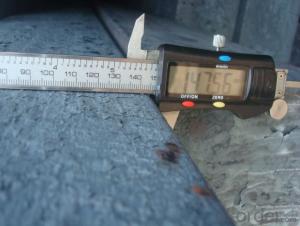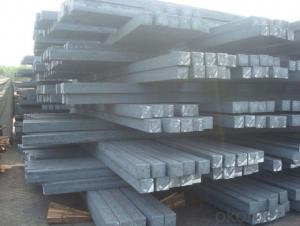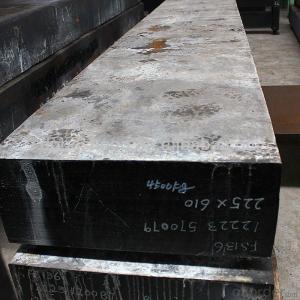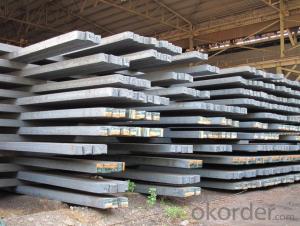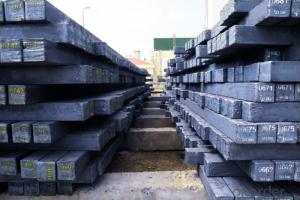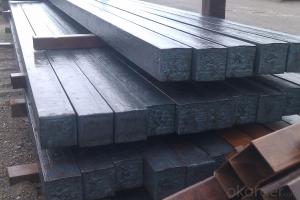Prime Q275 175mm Square Alloy Steel Billet
- Loading Port:
- Shanghai
- Payment Terms:
- TT OR LC
- Min Order Qty:
- 100 m.t.
- Supply Capability:
- 10000 m.t./month
OKorder Service Pledge
OKorder Financial Service
You Might Also Like
Structure of Prime Q275 175mm Square Alloy Steel Billet
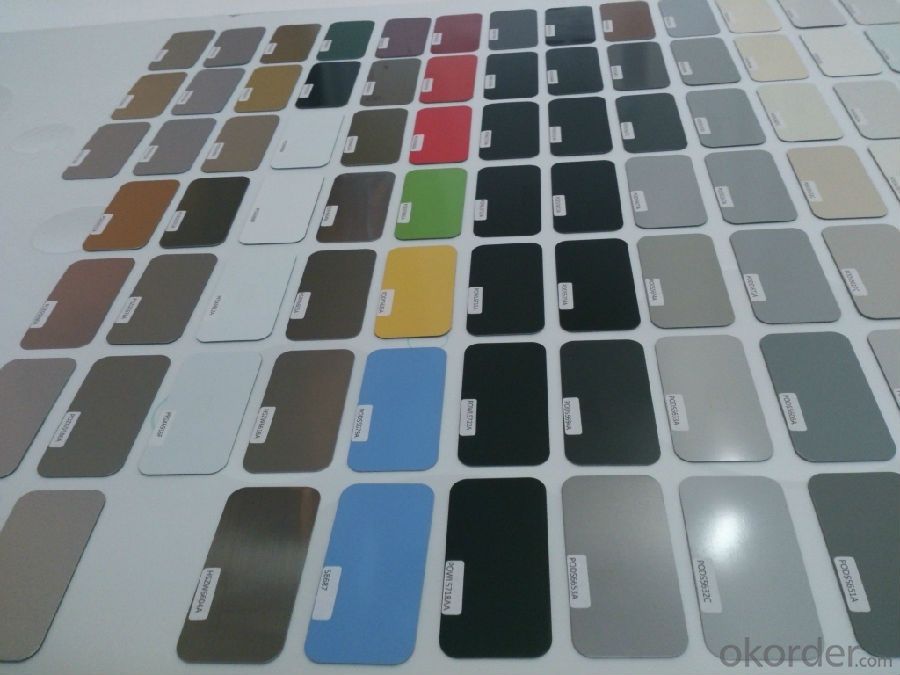
Description of Prime Q275 175mm Square Alloy Steel Billet
1. Prepainted steel coil is coated with organic layer, which provides higher anti-corrosion property and a longer lifespan than that of galvanized or galvalume steel sheets.
2. The base metals for prepainted steel coil consist of cold rolled, HDGI Steel, electro-galvanized and hot-dip alu-zinc coated steel. The finish coats of prepainted steel coil can be classified into groups as follows: polyester, silicon modified polyesters, polyvinylidene fluoride, high-durability polyester, etc.
3. The production process has evolved from one-coating-and-one-baking to double-coating-and-double-baking, and even three-coating-and-three-baking.
4. The color of the prepainted steel coil has a very wide selection, like orange, cream-colored, dark sky blue, sea blue, bright red, brick red, ivory white, porcelain blue, etc.
5. The prepainted steel coils can also be classified into groups by their surface textures, namely regular prepainted sheets, embossed sheets and printed sheets.

Main Feature of Prime Q275 175mm Square Alloy Steel Billet
They were one of several reasons for the wind to be taken out of the sails of the recent oil price momentum. Kuwait’s oil minister said that his country would only commit to a production freeze if all major producers are involved, including Iran. We also had Goldman telling us that oil markets will not rebalance at $40/bbl as it throws a lifeline to cash-strapped US producers.
If it is talk of a production freeze that is behind the rally it shows how low expectations have fallen. It is in the nature of oil people to talk the market up. Any bullish crumb is given exaggerated significance and any port in a storm will do. It is all but fact that the oil market will be tighter in the second half of this year when seasonal demand shoots up and US production continues to decline. It was the same picture last year. If OPEC and key non-OPEC production is frozen that will ensure the daily surplus will fall, but in all likelihood there will still be a surplus and there is an enormous global stockbuild to burn off.
Applications of Prime Q275 175mm Square Alloy Steel Billet
A. Corrugated design makes it excellent waterproof performance
B. Materials as prepainted steel sheets, galvanized steel sheets, galvalume (Al-Zn coated sheets) are available to make corrugated sheet.
C.Those material are durable, anti-corrosion in bad weather for 20-30 years based on it's Zinc(Galvanized) coating or AZ (Galvalume) coating.
D. Different shape of the sheet make it suitable for any style of buildings.
E.Easy to install, no need special tools to fix the sheet.
F.Light weight due to high strength to weight ratio of steel. Light weight means easier handling lower shipping costs, easier installation
G. Different color is availbe base on the RAL Standard make your building more beautiful.
H. We will provide the best solutions if you don't have a exact idea of the specification you want for the steel sheet based on your weather conditions, engineering structure, construction budget and so on.
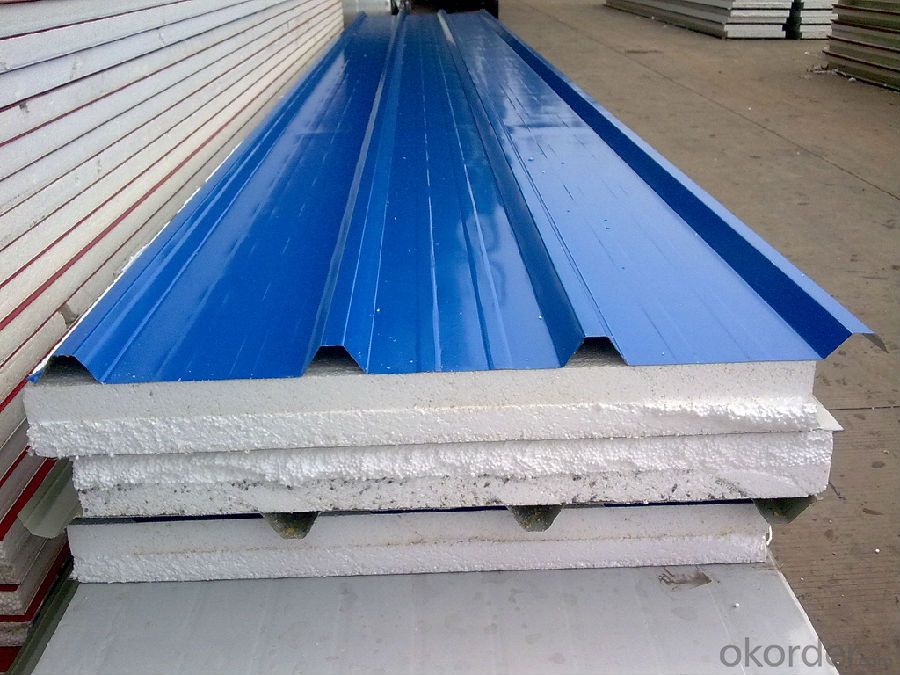
Specifications of Prime Q275 175mm Square Alloy Steel Billet
Product | Billet |
Material Grade | SGCC / SGCH / DX51D+AZ, etc |
Thickness | 0.6-3.0mm |
Width | 500-1500mm |
Tolerance | Thickness: +/-0.02mm , Width:+/-2mm |
Zinc-coating | Z30-150g/m2 |
Technique | Raw material: Hot rolled steel coil --> Cold rolled_>hot dipped galvalume |
Surface | Dried, Chromated, Unoiled |
Spangle | Regular spangle , small spangle, zero spangle |
ID | 508MM 610MM |
Coil weight | 1-25MT |
Export package | Cardboard inner sleeves, Waterproof paper, galvanized steel covered and steel strip packed |
FAQ of Prime Q275 175mm Square Alloy Steel Billet
We have organized several common questions for our clients,may help you sincerely:
1. How Can I Visit There?
Our company is located in Tianjin City, China, near Beijing. You can fly to Tianjin Airport Directly. All our clients, from home or aboard, are warmly welcome to visit us!
2. How Can I Get Some Sample?
Poor trade figures from China punctured commodity optimism yesterday although they came with warnings that perhaps the numbers were distorted by Chinese New Year celebrations and we will have to wait for the March figures to gain a true picture of the state of China’s landing. Exports for February were -25.4% and imports -13.8% year-on-year.
- Q: What are the main factors affecting the dimensional accuracy of steel billets?
- The dimensional accuracy of steel billets can be influenced by several key factors. To begin with, the casting process's temperature is of utmost importance. Steel billets are typically cast at high temperatures, and any fluctuations or inconsistencies in temperature can result in dimensional inaccuracies. If the temperature is too high, the billet may expand, leading to dimensions larger than desired. Conversely, if the temperature is too low, the billet may contract, resulting in smaller dimensions than intended. Therefore, it is crucial to maintain a consistent and controlled temperature to achieve dimensional accuracy. Furthermore, the cooling process after casting also impacts the dimensional accuracy of steel billets. Rapid cooling can cause uneven contraction, leading to distortions in dimensions. Conversely, slow cooling can cause excessive growth and expansion of the billet. Hence, it is necessary to carefully control and optimize the cooling rate to ensure uniform and accurate dimensions. Moreover, the design and condition of the casting molds significantly influence the dimensional accuracy of steel billets. The mold should be appropriately designed to accommodate shrinkage and compensate for potential distortions. Additionally, the mold's condition, such as wear and tear or improper alignment, can also contribute to dimensional inaccuracies. Regular maintenance and inspection of molds are essential to ensure proper functioning and minimize any impact on dimensional accuracy. Finally, the composition and quality of the steel itself can affect the dimensional accuracy of the billets. Variations in chemical composition or impurities in the steel can lead to inconsistencies in the cooling and solidification process, resulting in dimensional inaccuracies. Hence, stringent quality control measures and precise composition monitoring are necessary to minimize variations in the steel and maintain dimensional accuracy. In conclusion, temperature control during casting, the cooling process, the design and condition of casting molds, and the composition and quality of the steel are the main factors affecting the dimensional accuracy of steel billets. By closely monitoring and controlling these factors, manufacturers can ensure the production of steel billets with accurate dimensions.
- Q: How long do steel billets last?
- The longevity of steel billets varies depending on multiple factors, including their storage conditions and utilization. Provided that they are stored appropriately in a controlled environment with low humidity and shielded from corrosion, steel billets can endure indefinitely. Conversely, if they are exposed to harsh weather, excessive moisture, or corrosive substances, their lifespan can be significantly diminished. As for their usage, steel billets are typically melted and transformed into other steel products, such as bars, rods, and beams. The lifespan of the final product hinges on its specific application and the maintenance practices implemented. Generally, steel products are renowned for their durability and longevity, rendering them a dependable option in numerous industries.
- Q: What is the impact of impurities on the quality of steel billets?
- The quality of steel billets is greatly influenced by impurities. Steel billets, which serve as raw materials for various steel products, can be negatively affected by the presence of impurities. To begin with, the mechanical properties of steel billets can be weakened by impurities. For example, sulfur can cause sulfide inclusions, which reduce the strength and toughness of the steel. Similarly, phosphorus can lead to phosphide inclusions that negatively impact the ductility and impact resistance of the billets. These impurities can also promote the formation of cracks and other defects, further compromising the quality of the steel. Additionally, the machinability of steel billets can be adversely affected by impurities. Higher levels of impurities can increase the hardness and decrease the machinability of the steel, making it more challenging to shape into the desired end products. Consequently, this can lead to increased processing time and cost, as well as reduced productivity. Furthermore, the surface finish of steel billets can be impacted by impurities. Oxide inclusions, which are commonly formed due to impurities, can cause surface defects and roughness. This can negatively affect the appearance and aesthetics of the final steel products, making them less desirable in the market. Moreover, impurities can influence the corrosion resistance of steel billets. Some impurities, like chromium and nickel, can improve the corrosion resistance of steel. However, other impurities such as sulfur and phosphorus can promote corrosion, decreasing the lifespan and reliability of the steel products made from these billets. In conclusion, impurities have a significant impact on the quality of steel billets, resulting in weakened mechanical properties, reduced machinability, compromised surface finish, and decreased corrosion resistance. Therefore, it is crucial for steel manufacturers to carefully control and minimize the presence of impurities during the production process to ensure the production of high-quality steel billets.
- Q: What are the different methods of steel billet surface grinding?
- There are several methods of steel billet surface grinding, including abrasive grinding, belt grinding, and centerless grinding.
- Q: How are steel billets used in the manufacturing of machinery?
- Steel billets are an essential component in the manufacturing of machinery due to their versatility and strength. These cylindrical metal bars, typically made from carbon or alloy steel, serve as the raw material that is transformed into various machine parts and components. One common application of steel billets in machinery manufacturing is for the production of machine frames and structures. The billets are heated and then hot-rolled or forged into the desired shape, ensuring the final product has the necessary strength and durability to withstand the mechanical stresses it will encounter during operation. Additionally, steel billets are used to create machine components such as gears, shafts, and axles. These parts require high tensile strength and resistance to wear and deformation, making steel billets the ideal material choice. The billets are typically machined or forged into the desired shape, ensuring precise dimensions and tolerances are met. Furthermore, steel billets can also be used in the manufacturing of machine tools, which are crucial for shaping and machining various materials. By using steel billets as the base material, machine tools can effectively handle heavy loads, provide stability, and ensure precision in the manufacturing processes. In summary, steel billets are integral to the manufacturing of machinery, as they provide the necessary strength, durability, and versatility required for the production of machine frames, components, and tools. Their ability to be shaped, machined, and forged into various forms allows for the creation of high-quality machinery that can effectively perform its intended functions.
- Q: How are steel billets used in the production of transmission towers?
- Steel billets are an essential component in the production of transmission towers. These billets, which are semi-finished steel products, serve as the raw material for the construction of these towers. To begin, the steel billets are first heated at extremely high temperatures in a furnace. This heating process, known as hot rolling, helps to soften the billets and make them more malleable, allowing them to be easily shaped and formed into the desired structure of the transmission tower. Once the billets have been heated, they are then passed through a series of rolling mills, where they are shaped into long, cylindrical sections known as steel bars. These bars are then further processed and cut to the required length and dimensions, depending on the specific design and requirements of the transmission tower. After the bars have been cut and shaped, they undergo a process called galvanization. This involves coating the steel bars with a layer of zinc, which provides corrosion resistance and protects the tower from environmental elements such as moisture and rust. Finally, the galvanized steel bars are assembled and welded together to form the intricate framework of the transmission tower. The strength and durability of the steel billets used in this process ensure that the tower can withstand the heavy loads and extreme weather conditions it is subjected to. Overall, steel billets play a crucial role in the production of transmission towers as they provide the necessary strength, flexibility, and corrosion resistance required for these structures. Their ability to be shaped and formed into the desired dimensions, along with their durability, make them an ideal material for the construction of transmission towers.
- Q: What are the different types of steel billet forging defects?
- During the forging process, various steel billet forging defects may arise, each with its own causes and potential impact on the final forged product's quality and integrity. The common defects encompass the following: 1. Surface cracks, resulting from excessive heating or cooling, improper forging techniques, or the presence of impurities in the steel, manifest as cracks on the billet's surface. 2. Internal voids, caused by incomplete mold filling, inadequate venting, or trapped gases within the steel, form cavities or voids within the billet. 3. Inclusions, consisting of foreign materials or impurities within the billet, like non-metallic particles (e.g., oxides or sulfides) or metallic impurities (e.g., slag), can weaken the steel structure and diminish overall quality. 4. Segregation, which occurs during the cooling process, refers to the uneven distribution of alloying elements within the billet, leading to different mechanical properties in distinct areas of the steel and resulting in inconsistencies in the final product. 5. Dimensional inaccuracies, arising from improper tooling or die design, inadequate heating or cooling processes, or improper handling during forging, refer to deviations from the desired shape or size of the billet. 6. Grain structure abnormalities, influenced by factors such as improper heating or cooling rates, can weaken the steel and reduce its mechanical properties by altering the grain structure. To ensure the quality and reliability of the final forged product, it is crucial to detect and address these defects during the production process. Quality control measures, including non-destructive testing and visual inspections, can aid in identifying and rectifying these defects before delivering the finished product to the customer.
- Q: What are the different types of mechanical property testing methods for steel billets?
- There are several different types of mechanical property testing methods used to evaluate the quality and strength of steel billets. These methods include: 1. Tensile Testing: Tensile testing is one of the most commonly used methods to determine the mechanical properties of steel billets. It involves applying a tensile force to a small sample of the billet until it fractures. This test measures the strength, yield strength, elongation, and reduction in area of the material. 2. Impact Testing: Impact testing is used to assess the toughness and resistance to fracture of steel billets. It involves striking a notched specimen with a pendulum or hammer and measuring the energy absorbed during fracture. The results provide information about the material's ability to withstand sudden shocks or dynamic loads. 3. Hardness Testing: Hardness testing determines the resistance of the steel billet to indentation or scratching. Various methods can be employed, such as Rockwell, Brinell, or Vickers hardness testing. The results are often correlated with other mechanical properties, such as strength and ductility. 4. Charpy Testing: Charpy testing is a type of impact test specifically designed to evaluate the notch toughness of steel billets. It involves striking a notched specimen with a pendulum, and the energy absorbed during fracture is measured. This test is particularly useful in assessing the material's behavior under low-temperature conditions. 5. Bend Testing: Bend testing is performed to assess the ductility and flexibility of steel billets. It involves bending a sample around a specified radius until it fractures or shows signs of cracking. This test provides information about the material's ability to withstand deformation without breaking. 6. Fatigue Testing: Fatigue testing is used to evaluate the steel billet's resistance to cyclic loading or repeated stress. It involves subjecting a sample to a varying load, and the number of cycles required for failure is recorded. This test helps determine the material's durability and its ability to withstand long-term stress. These mechanical property testing methods play a crucial role in ensuring the quality and reliability of steel billets for various applications. By evaluating the strength, toughness, hardness, and other mechanical properties, manufacturers and engineers can make informed decisions about the suitability of the material for specific uses.
- Q: Can steel billets be used for artistic purposes?
- Yes, steel billets can be used for artistic purposes. Steel is a versatile material that can be shaped, welded, and manipulated to create various artistic sculptures, structures, and decorative pieces. It offers strength, durability, and a modern aesthetic, making it a popular choice among artists and designers. Additionally, steel can be painted, polished, or oxidized to create different visual effects, allowing artists to experiment and showcase their creativity.
- Q: Can steel billets be used in the production of industrial equipment?
- Industrial equipment can indeed utilize steel billets. These semi-finished metal products can undergo further processing to produce a wide range of industrial equipment, including machinery, tools, automotive parts, construction materials, and more. Steel's exceptional strength, durability, and adaptability make it the perfect material for manufacturing industrial equipment. By shaping, machining, and welding steel billets, intricate structures and components can be created, ensuring the necessary strength and stability for industrial applications. Furthermore, heat treatment can be applied to steel billets to enhance their mechanical properties, making them even more suitable for heavy-duty industrial equipment.
Send your message to us
Prime Q275 175mm Square Alloy Steel Billet
- Loading Port:
- Shanghai
- Payment Terms:
- TT OR LC
- Min Order Qty:
- 100 m.t.
- Supply Capability:
- 10000 m.t./month
OKorder Service Pledge
OKorder Financial Service
Similar products
Hot products
Hot Searches
Related keywords
